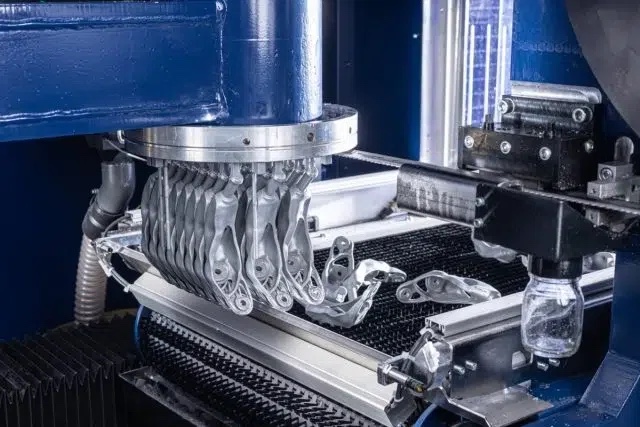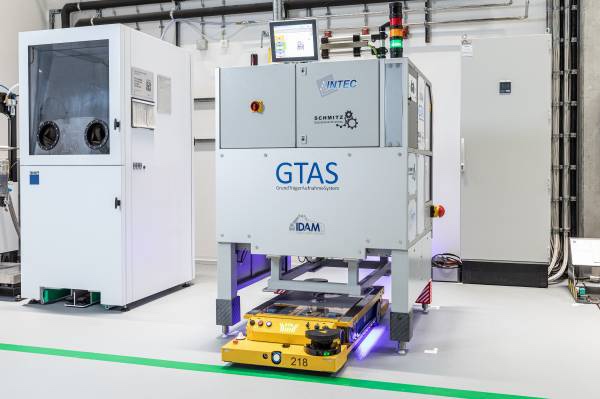Three years ago, 12 companies and research institutions working at the intersection of the German automotive and additive manufacturing (AM) industries formed a consortium for the purpose of completing a project called IDAM: the Industrialization and Digitalization of Additive Manufacturing. The goal of the project — which was led by BMW Group, and funded by the German Federal Ministry of Education and Research (BMBF) — was nothing less than “to revolutionize metal 3D printing in standard production of cars.”

BMW announced on Tuesday, May 24, that the project had been successfully implemented. Success in this case entails two fully automated, 3D printed automotive production lines now being ready for operation: one at the BMW Group AM Campus in Oberschleißheim, a suburb of Munich, and the other at the GKN Metallurgy division plant in Bonn, Switzerland, owned by the U.K.-based automotive and aerospace components multinational, GKN Ltd.
The consortium’s leader, and BMW Group’s project manager for IDAM, Felix Haeckel, commented in a press release, “From the very first day of the project, you could feel the team spirit among the partners. Learning from one another, developing innovative solutions together and making the best use of each partner’s individual strengths — those were key to successful industrialization and digitalization of additive manufacturing.”

By utilizing systems made up of laser powder bed fusion (LPBF) platforms, combined with AI and robotics, that it has developed, the IDAM consortium can print 50,000 series parts a year, as well as 10,000 new and individual parts. Opened in 2020, BMW’s campus at Oberschleißheim has 50 3D printers for both metal and plastics. Aside from investing in a variety of 3D printing startups, including Desktop Metal and Xometry, the company also employs HP MultiJet Fusion (MJF) and EOS machines, among other brands.
BMW has been using 3D printing in its production lines for about 30 years, and prior to announcing the €15 million AM Campus in 2019, the company had already produced 1,000,000 3D printed parts. Considering that 3D printing for the automotive industry in general is moving towards series production, the IDAM consortium is obviously at the cutting edge of automation in car manufacturing. Given its being so ahead-of-the-curve on such a critical industry-wide shift, BMW is perfectly poised to continue meeting its financial expectations amidst recession worries and supply chain breakdowns.

According to BMW, the company ships “7,000 containers with a total of 31 million components” everyday. In that sense, then, 60,000 printed parts, in the scope of BMW’s whole operations, doesn’t seem like much. On the other hand, from the perspective of the AM sector, the IDAM project conveys a very clear message as to what “scale-up” — the main objective of the phase the industry has just entered — will truly look like. It’s unlikely, for the near future, that any automotive company will 3D print a majority or even a significant minority of the new parts for any model. What is likely is that over the next five to ten years, BMW could put an AM Campus in every one of the 15 countries where it operates. It’s similarly likely that an increasing number of critical parts, with long lead times and unreliable supply chains, will be produced with 3D printing.
Thus, the success of this one project could realistically mean hundreds of machine orders over the next decade from BMW alone, not to mention the cost of service contracts and software and materials. Moreover, assuming the success of the project, it will likely have further positive impact on the AM sector, in the form of the emulation of what BMW is doing by other automakers. This would reflect the projections of SmarTech Analysis, which determined in the release of its most recent market data services report, that 3D printing for the auto industry will grow at a rate of 19.1 percent from 2021 to 2030. All of this begins to hint at how dependent the industry will be, if it’s going to continue to successfully scale-up, on the successful long-term increase of AM’s role in auto supply chains.
Images courtesy of BMW Press
Subscribe to Our Email Newsletter
Stay up-to-date on all the latest news from the 3D printing industry and receive information and offers from third party vendors.
Print Services
Upload your 3D Models and get them printed quickly and efficiently.
You May Also Like
3D Printing News Briefs, July 2, 2025: Copper Alloys, Defense Manufacturing, & More
We’re starting off with metals in today’s 3D Printing News Briefs, as Farsoon has unveiled a large-scale AM solution for copper alloys, and Meltio used its wire-laser metal solution to...
Etsy Design Rule Change Reduces Selection of 3D Printed Goods
Online marketplace Etsy has implemented a rule change requiring all 3D printed goods on the site to be original designs. The update to the site’s Creativity Standards states, ¨Items produced using...
Siraya Tech Introduces New Elastomer 3D Printing Materials, Including Foaming TPU
California company Siraya Tech, founded in 2019 with a focus on material science, customer focus, and agility, develops high-quality 3D printing materials that meet the needs of creators, hobbyists, and...
3D Printing News Briefs, April 12, 2025: RAPID Roundup
The news from last week’s RAPID+TCT in Detroit just keeps on coming! That’s why today’s 3D Printing News Briefs is another RAPID Roundup of more exciting announcements from the trade...


































